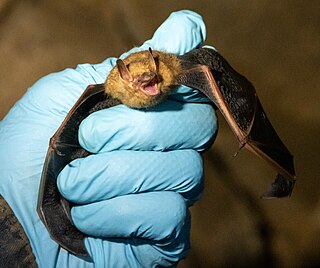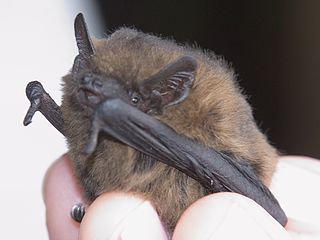
Pipistrellus is a genus of bats in the family Vespertilionidae and subfamily Vespertilioninae. The name of the genus is derived from the Italian word pipistrello, meaning "bat".

The tricolored bat or American perimyotis is a species of microbat native to eastern North America. Formerly known as the eastern pipistrelle, based on the incorrect belief that it was closely related to European Pipistrellus species, the closest known relative of the tricolored bat is now recognized as the canyon bat. Its common name "tricolored bat" derives from the coloration of the hairs on its back, which have three distinct color bands. It is the smallest bat species in the eastern and midwestern US, with individuals weighing only 4.6–7.9 g (0.16–0.28 oz). This species mates in the fall before hibernation, though due to sperm storage, females do not become pregnant until the spring. Young are born helpless, though rapidly develop, flying and foraging for themselves by four weeks old. It has a relatively long lifespan, and can live nearly fifteen years.

The common pipistrelle is a small pipistrelle microbat whose very large range extends across most of Europe, North Africa, South Asia, and may extend into Korea. It is one of the most common bat species in the British Isles. In Europe, the northernmost confirmed records are from southern Finland near 60°N.

The soprano pipistrelle is a small species of bat. It is found in Europe and often roosts on buildings.

The Japanese house bat, also known as Japanese pipistrelle, is a species of vesper bat. An adult has a body length of 3.6–4.8 cm (1.4–1.9 in), a tail of 2.9–4.0 cm (1.1–1.6 in), and a wing length of 3.2–3.6 cm (1.3–1.4 in). It prefers to roost under the ceiling or inside the roof of old buildings. It is found across East Asia, from China and Taiwan into the Ussuri region, the Korean Peninsula, and Japan.

Nathusius' pipistrelle is a small bat in the genus Pipistrellus. It is very similar to the common pipistrelle and has been overlooked in many areas until recently but it is widely distributed across Europe. It was described by two German naturalists, Alexander Keyserling and Johann Heinrich Blasius, and named by them after Hermann von Nathusius, in gratitude for his support of their research.
The angulate pipistrelle, also known as the New Guinea pipistrelle, is a species of vesper bat found in Papua New Guinea and the Solomon Islands.

Endo's pipistrelle is a species of vesper bat that is endemic to Japan. It is found in temperate forests.

Kuhl's pipistrelle is a species of vesper bat that occurs in large areas of North Africa, Southern Europe and West Asia. It lives in temperate forests, subtropical or tropical dry shrubland, Mediterranean-type shrubby vegetation, temperate grassland, rural gardens, and urban areas. It is a rare and infrequent visitor to Britain, usually only detected by sound-recordings. A specimen held at the Palestine Natural History Museum is the first record of the species to be "ensnared by a plant in the Arab world".

The Madeira pipistrelle is a species of vesper bat. It is endemic to Azores, Madeira and the Canary Islands.
The lesser Papuan pipistrelle is a species of vesper bat. It can be found in Indonesia and Papua New Guinea.

The Mount Popa pipistrelle is a species of vesper bat. It is found in China, India, Myanmar, Thailand, and Vietnam.

The least pipistrelle is a species of vesper bat.
Watt's pipistrelle is a species of vesper bat found only in Papua New Guinea.

The Vespertilioninae are a subfamily of vesper bats from the family Vespertilionidae.

The Christmas Island pipistrelle is an extinct species of vesper bat that was found only on Christmas Island, Australia. The last individual bat was seen in August 2009 with no further sightings despite intensive efforts to locate it.

Pipistrellus raceyi, also known as Racey's pipistrelle, is a bat from Madagascar, in the genus Pipistrellus. Although unidentified species of Pipistrellus had been previously reported from Madagascar since the 1990s, P. raceyi was not formally named until 2006. It is apparently most closely related to the Asian species P. endoi, P. paterculus, and P. abramus, and its ancestors probably reached Madagascar from Asia. P. raceyi has been recorded at four sites, two in the eastern and two in the western lowlands. In the east, it is found in open areas and has been found roosting in a building; in the west it occurs in dry forest. Because of uncertainties about its ecology, it is listed as "Data Deficient" on the IUCN Red List.
Hanak's dwarf bat or Hanak's pipistrelle is a species of bat only found in Cyrenaica, Libya and Crete, Greece.
The Dhofar pipistrelle is a species of vesper bat in the genus Pipistrellus. It is found in Southern Arabia, including Oman and Yemen.

Pipistrellini is a tribe of bats in the family Vespertilionidae. It contains several genera found throughout the Old World and Australasia, including the pipistrelles, noctules and related species.













